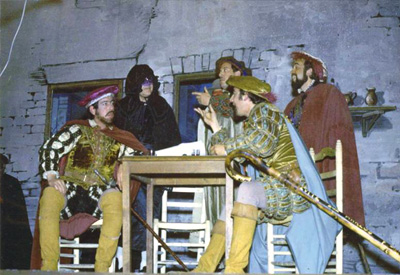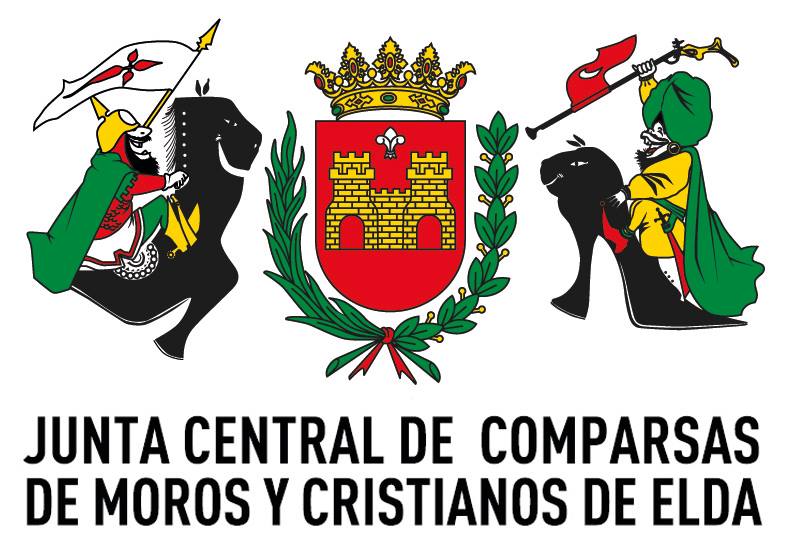Junta Central Theatre Group

The link of the "Tenorio" with the Central Board, has its origins in 1972, being Jenaro Vera president of the same and active member of the group. In those years the Central Board of Comparsas organized "The Week of Humor" which began in 1971 with the First National Competition of Humorous Drawings, which was the contact with the cartoonist from Madrid Serafin, who gave rise to several covers of the Magazines of Celebration between 1971 and 1985, as well as a Book Fair of Humor, and conferences, with speakers of the stature of Evaristo Acevedo and Jorge Llopis, among others. In April 1972, as an additional act to the Week of Humor, Jenaro Vera included the representation of El Señor Don Juan Tenorio or dos tubos un real that had stopped being represented in 1961. It happened that the staging was so successful and pleased the audience that Jenaro decided to continue performing it on its date of December 28th, thus resuming an old Eldense tradition that had been on the verge of disappearing.
The first years the Central Board was mentioned in the posters as the organizer of the event. It was in 1976 when it began to be called "Grupo Artístico de la Junta Central de Comparsas", appearing other times as "Grupo de Teatro de la Junta Central". This group during the early eighties, not only took care of the representation of the "Tenorio", but also made other comedy comedies, such as "Que listo es Calixto", "El Casado casa quiere", "La locura de Don Juan", "Anacleto se divorcia" and "Usted puede ser un asesino".
It is from the year 1999 when it is incorporated in the organization chart of the Board of Governors of the Central Board to the "Grupo de Teatro" as one more commission.
The origins of Emilio Rico's Tenorio eldense
"El Señor Don Juan Tenorio o dos tubos un real" was released on December 28, 1919. Its author Emilio Rico Albert, began to conceive the idea of the parody of the figure of Don Juan, based on the work of José Zorrilla, premiered on March 28, 1844 and that went on stage punctually on the Day of the Dead or All Saints' Day, in November. It is more than likely that Emilio Rico, when writing his "Tenorio", already had the clear idea to represent it also punctually as Zorrilla's, but due to its humorous, critical and sly content, instead of the Day of the Dead, what better than the Day of the Innocents which lent itself better to a day of surprises and jokes, and so that nobody could feel uncomfortable in case of being alluded to.
It has been speculated with certain frequency about the date of the premiere of the "Tenorio", affirming that it was in the year 1921, even later it was given as more probable 1923, but when investigating about the life of Emilio Rico we discovered, consulting the numbers of the local weekly "Valle de Elda" in the newspaper library of the Municipal Library, that in number 179, dated January 30, 1960, in a published interview, made to Emilio Rico himself, he confirmed the date of the premiere placing it on December 28, 1919.
Emilio Rico, in love with Zorrilla's work, had worked on a parody of Don Juan Tenorio, thinking in a "cagaldero" language and changing Butarelli's nationality from Italian, as in Zorrilla's work, to Valencian.
Emilio, related to the group, proposed to put in scene the work that was about to finish writing and that he had baptized with the name of The Lord Don Juan Tenorio or two tubes a real one.
Once the contact with a local theatre group of the time directed by Antonio Cremades was made, and with the important collaboration of José Verdú, the moment arrived to carry out the performance and decide on the cast. Emilio Rico had it very clear. The female roles, to make matters worse, would be played by men, thus emulating the way medieval theatre was done. It is not certain when rehearsals began, nor if Emilio Rico had the ending of the play decided, but it is possible to situate them in the first months of the year in which it was premiered, in 1919. The director, Antonio Cremades, undertook the hard task of leading the movement of the actors and nuancing the diction of the role, although some of them had already demonstrated their artistic qualities on stage, as was the case of the author Emilio Rico, who undoubtedly played the role of his Don Juan.
Another question that was raised in those first meetings was the date of the premiere. Why not the first of November, which is the traditional date of the Tenorio de Zorrilla... Doubts would surely arise. It is more than likely that Emilio pointed out, with his characteristic humour, that if it was performed in November, the audience could react "dangerously" against the actors. So it was better to play on December 28th, April Fools' Day, which was a date that lent itself to jokes and carelessness.
The trials finally started. The place, one of the dependencies of one of the most important footwear factories of the time, La Industria Española del Calzado, was located in the same space that today occupies the Ernes Building. One of the members of the group was related to the factory, and as there was enough space, the rehearsals were held there for several years, as well as sometimes at the home of Jenaro Vera's parents.
One of the first steps, that year 1919, was the distribution of papers. The first cast in the history of El Señor Don Juan Tenorio or dos tubos un real was assumed by the following actors:
DON JUAN.- Emilio Rico Albert.
DOÑA INÉS.- Santiago Pomares (a.) Talega.
DOÑA BRÍGIDA.-Pascual Gil (a.) Pascualico Tartana.
DON LUÍS LEJÍAS.- Ángel Vera Coronel.
EL COMENDADOR.- Jesús Gil Ponce.
DON DIEGO.- Sebastián Rosas del Bosque.
BUTARELLI.- Juan M. Llopis Taltabull.
CHUTTI.- Antonio Cremades.
DIRECTOR.- Antonio Cremades.
José María Pérez Gras was in charge of the prompting, Luis Maestre Coronel, father of the current Pedro Maestre Guarinos, was in charge of the ticket sales at the box office. In the group was also Francisco Candelas Carratalá, who after several years, would take over the role of La Inés, playing a very important role in the history of the "Tenorio", as we will see later. And José Verdú, who helped in the tasks of pointing and tracing. Soon new actors joined the cast as there were some casualties, such as Sandalio Requena, Antonio Vera, and José Rico Prats, the popular "Nata", who played for several years, another of the memorable "Ineses". That December 28th there was great expectation in Elda. The brand new Castelar Theatre, which had only been in existence for fifteen years, registered a full house, exceeding all expectations. There was an audience even in the corridors. Such was the crowding and the people who stayed at the door without being able to enter that the mayor, fearing some altercation, went out to the door accompanied by the civil guard, to calm down and promise them that the play would be repeated after eight days. And so it was, both performances were a resounding success. The audience had a great time laughing throughout the performance, not knowing that while the play was being performed, on the day of its premiere, the author Emilio Rico was walking around the dressing rooms, at the moments when he was not on stage, writing the end of the last act, which was then quickly transcribed by José Verdú so that the prompters could do the rest.
It is difficult to know whether that amateur theatre group, or even the author himself, was aware at that time of what that premiere was going to mean for the cultural life of Eldense. There is no doubt that the cultural phenomenon that the play represents for the people of Eldense and that is enduring over time, has its reason in the text written by Emilio Rico, who saving generations, year after year, connects perfectly with the local idiosyncrasy, through its critical and sly ingredients that give it actuality, with the surprises of the "End of the Party", and above all because the script continues to maintain its freshness, especially in certain passages where systematically the public has laughed, laughs and will continue to laugh, as long as the tradition of representing it is maintained.
